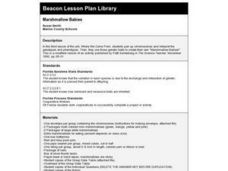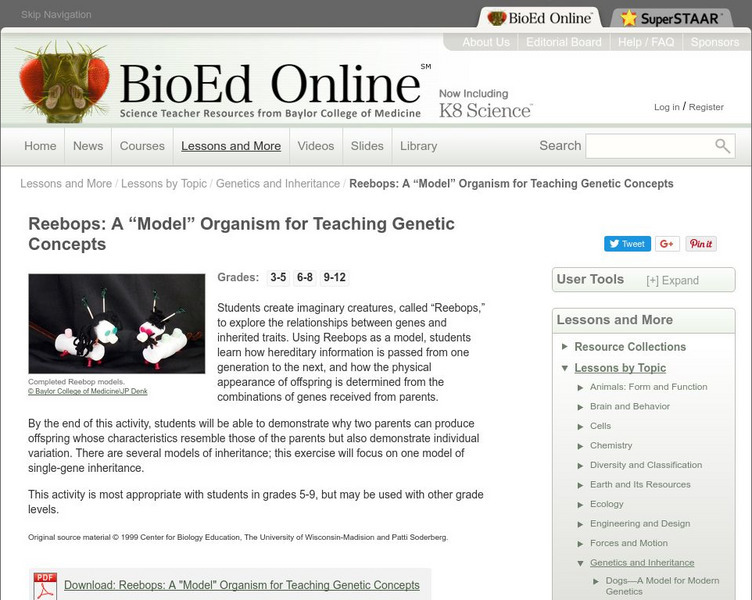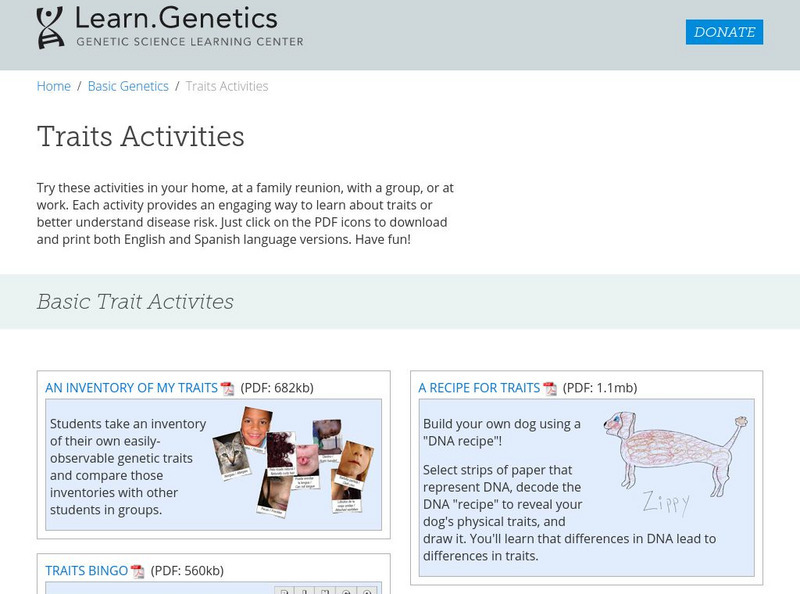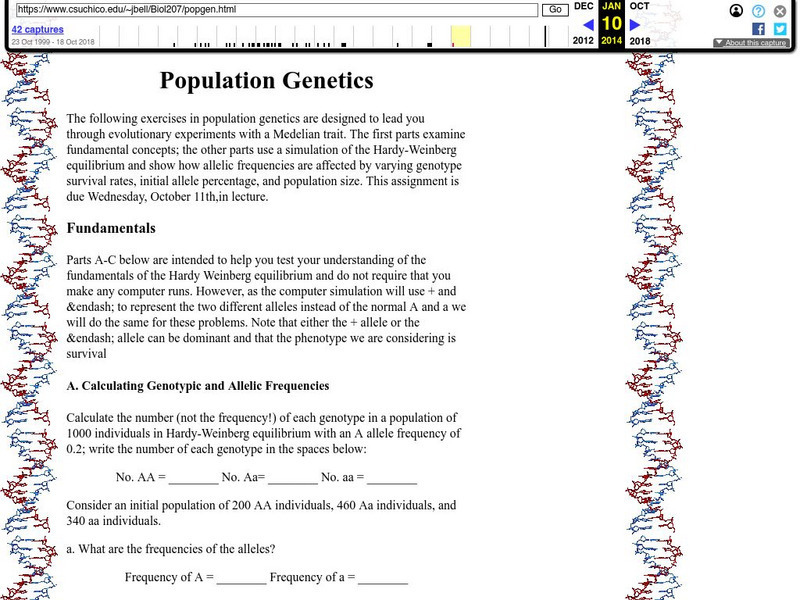Curated OER
Drosophila Melanogaster
Students cross wild type flies and mutants, both purchased from a biological supply house (Carolina Biological Supply or Wards, for example) in groups from lesson one.
Curated OER
Born of Blood
Eighth graders use a large Punnett Square and infer how genes determine blood types. In this blood type instructional activity students predict blood types and demonstrate how Punnett Squares are related to genes and...
Curated OER
Marshmallow Babies
Eighth graders interpret the genotypes and phenotypes, then pair up chromosomes.
Curated OER
Square Dancing
Fourth graders investigate the concept of using punnett squares in the determination of the offspring.They collect drawings and pictures and create a collection for student science journals.
Curated OER
Candy Dish Selection
Students explore natural selection. They explore the concepts of adaptations, and the way which random factors affect the survival of individuals and populations.
Utah STEM Foundation
Utah Stem Action Center: Inherited Traits
Ever wondered why you might look like your parents? Or an animal cub my look like its mom? Learn about inherited traits with this quick and easy activity.
PBS
Pbs Learning Media: Mendel's Laws of Genetic Inheritance
This interactive activity, adapted from the Dolan DNA Learning Center, uses Punnett squares to illustrate Mendel's laws of inheritance and how a particular gene combination results in a 3-to-1 ratio of dominant-to-recessive traits.
BioEd Online
Bio Ed Online: Reebops: A "Model" Organism for Teaching Genetic Concepts
In this lesson students create imaginary creatures, called "Reebops," to explore the relationships between genes and inherited traits. Using Reebops as a model, students learn how hereditary information is passed from one generation to...
Center for Innovation in Engineering and Science Education, Stevens Institute of Technology
Ciese: Human Genetics Project: Is the Dominant Trait Most Prevalent?
Human-Genetics: A Worldwide Search for the Dominant Trait allows you to collect data and share your results with students around the world. Register your class, complete the student survey, participate in discussion boards, and interact...
Cold Spring Harbor Laboratory
Dna From the Beginning: Genetic Inheritance Follows Certain Rules
Find out what happened when Mendel crossed two hybrid pea plants. The animations do a good job explaining why these crosses produce a 3:1 ratio of traits.
Concord Consortium
Concord Consortium: Stem Resources: Modern Genetics
Try your hand at mating dragons to learn about genetic recombination, meiosis, and inherited traits. Understand how chromosomes separate in meiosis with a science animation. Then change alleles for the dragons to see what happens to...
Vision Learning
Visionlearning: Biology: Genetics I: Mendel's Laws of Inheritance
Instructional module focusing on Gregor Mendel's Laws of Inheritance. Discussion includes Mendel's discovery of dominant and recessive traits as well as co-dominance and incomplete dominance in genetics. Site also includes an interactive...
The Association of the British Pharmaceutical Industry
Abpi: Genes and Inheritance
A complete, student-paced lesson on genetics and inheritance. Students work their way through illustrations and animated tutorials, and answer review questions along the way. There is a self-checking quiz at the end of the lesson.
University of Utah
University of Utah: Genetic Science Learning Center: teach.genetics: Introduction to Heredity
A three-day unit introduces heredity by helping students identify their own genetic traits and then leading them in an exploration of generational traits and variation. Find printable worksheets, data tables, and graphs, as well as...
eSchool Today
E School Today: Your Cool Tips on Genetics
Explains basic genetics concepts, including genes, DNA, chromosomes, sex chromosomes, how traits are inherited, genetic variation, cloning, and stem cells.
University of Utah
University of Utah: Genetic Science Learning Center: Traits Activities
A collection of genetic learning activities provides an engaging way to learn about traits, or better understand disease risk.
University of Utah
University of Utah: Genetic Science Learning Center: Heredity and Traits
The Genetic Science Learning Center presents the world of heredity and traits including activities to better comprehend the science, clear explanations of aspects of heredity, and an interactive opportunity.
OpenStax
Open Stax: Anatomy & Physiology: Patterns of Inheritance
Students learn about patterns of inheritance including genotype and phenotype, and then learn about the inheritance of autosomal dominant and recessive and sex-linked genetic disorders.
ArtsNow
Arts Now Learning: The Gene Connection Show [Pdf]
Fifth graders will discover the difference between inherited traits and learned behaviors by bringing the traits to life in a game of charades. After that, the students will demonstrate knowledge of recessive and dominant traits as they...
California State University
Csu Chico: Population Genetics
This is a group of Mendelian Genetics exercises that are designed to show the evolution of a trait within a population. The site covers instruction in calculating genotypic and allelic frequencies, determining dominance, the...
CPALMS
Florida State University Cpalms: Florida Students: Complex Modes of Inheritance
A tutorial reviews polygenic and multiple alleles, Punnett Square, sex-linked trait, and inheritance patterns. Follow the slides to ensure comprehension of inheritance.
University of Washington
Genome Sciences Education Outreach: State Your Traits (High School Level) [Pdf]
Multi-activity instructional activity focuses on genetics and the basic principles of inheritance.
Palomar Community College District
Palomar College: Mendels' Genetics
This site from Palomar College provides a good background on exactly what Mendel did. Vocabulary links throughout make this a very good introduction article for genetics.
Estrella Mountain Community College
Estrella Mountian College: Introduction to Genetics
This site explains genetic beliefs before and after Mendel, and also includes a section on Mendel himself and his experiments, entitled, "The Monk and his Peas".





















